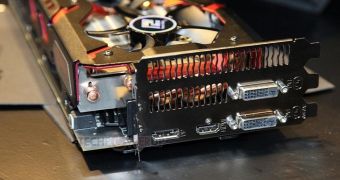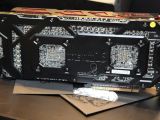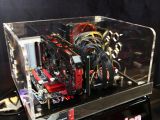Now that NVIDIA's GeForce GTX Titan Z dual-GPU card has debuted and still holds onto the astonishing price of $3,000 / €3,000, the half-priced but more or less similar in performance AMD Radeon R9 295 X2 will probably sell better than ever.
Sure, loyalists will still buy NVIDIA's card, and maybe that's why the green logo-bearing company took the chance and set the price so high.
Because the few people likely to buy it probably won't think twice about money anyway, rich as they'd have to be to even contemplate a hardcore piece of hardware like that.
Anyway, the Radeon R9 295 X2 has been around for a longer time than the NVIDIA board, which means that there are custom models from OEMs already.
The PowerColor Radeon R9 295 X2 Devil13 is one of them, and swaps the hybrid cooling module (liquid+air) for a triple-slot, triple-fan contraption (100 mm diameter fans to be exact).
Individual aluminum heatsinks cool the GPUs, while the bridge chip, VRM and memory are handled by a base plate.
Curiously enough, though, PowerColor isn't selling the newcomer under the R9 295 X2 name, but as a dual-R9 290X for some reason.
Don't be fooled though, it really is an R9 295 X2, with 4 GB of GDDR5 connected to each of the Hawaii XT chips, for a total of 8 GB.
512-bit interfaces link the GPUs to their respective RAM blocks, for a total 1024-bit width. A big number, even for dual-chip adapters.
The GDDR5 VRAM operates at 5 GHz by the way, and the GPU frequencies are of 1 GHz instead of the 1018 MHz on the R9 295 X2 (or, at least, that's what they were last time we learned anything about the PowerColor dual-R9 290X).
Moving on, PowerColor installed something of its own making on the adapter as well, besides the cooler: the Turbo Time patent-pending technology, which keeps the cooler active for a time even after you've turned off the PC.
We've seen it before, in power supplies, and it's something that helps maintain stability and endurance in the long term. Eliminating heat always does that, it seems. If you buy the PowerColor Dual-R9 290X Devil13 graphics card, you probably won't need to even think about a new video card for a decade or so.
The price of the product hasn't been outright stated even now, but it's bound to be of around $1,500 / €1,500 like for all its other peers.

 14 DAY TRIAL //
14 DAY TRIAL // 



